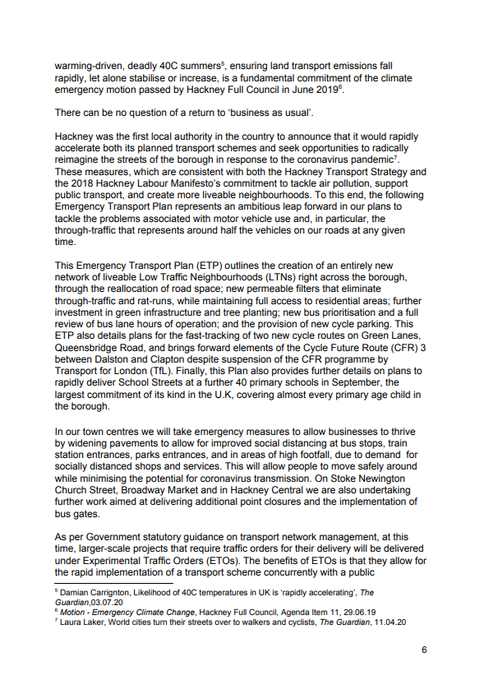
1/ You may have seen @Telegraph's & @TimHarford's coverage of recent DfT changes to road traffic stats, showing that 20.3bn miles were driven in London in 2019, not 22.6bn.
Low Traffic Neighbourhood enemies claim this means we don't need LTNs.
They're wrong. And I'll prove it.
Low Traffic Neighbourhood enemies claim this means we don't need LTNs.
They're wrong. And I'll prove it.

2/ Not rubbishing @transportgovuk's data, but 1993 👉2019 miles driven on the U.K's roads annually increased by 100 billion. 70% came from cars/taxis, yet the DfT have not explained why their new estimates show just a 200 million mile increase in London in the decade to 2019. 

3/ The 'smoking gun' for increasingly desperate Low Traffic Neighbourhood opponents, who've lost the argument, lost in court, and lost at the ballot box is that LTNs that based on the DfT's original data should be scrapped.
There are a couple of massive problems with this idea.
There are a couple of massive problems with this idea.
4/ Firstly, the claim that new LTNs were conceived because of DfT data showing a big increase in miles driven on London's roads is false.
I delivered the most LTNs in the U.K. Here's my intro to the 2020 Hackney Emergency Transport Plan. No reference to the DfT data whatsoever.


I delivered the most LTNs in the U.K. Here's my intro to the 2020 Hackney Emergency Transport Plan. No reference to the DfT data whatsoever.



5/ The 2nd problem for LTN opponents is that they cannot explain why 20.3 billion miles being driven in London is optimal, despite these conditions slowing down buses and exposing 99% of Londoners to unsafe levels of toxic particulates, both of which Onesies claim to care about. 

6/ Even if LTN opponents could prove that Londoners driving 20.3bn miles annually - mostly for short, discretionary journeys - was worth the price of stunted lungs in the kids of Hackney, which they cannot, they don't support any policies that could keep driving at 2019 levels.
7/ What the DfT, LTN opponents, and @TimHarford have been unable to explain is why a Satnav industry worth billions has been extremely successful at monetising rat-running everywhere *except* London? Seems a bit fishy that, doesn't it?
Come on Tim, surely a job for #moreorless?
Come on Tim, surely a job for #moreorless?

8/ Now, while we wait for the BBC to explain why Google bought Waze for $1 billion, if not to monetise data about our neighbourhoods for the benefit of rat-runners, let me explain how Low Traffic Neighbourhoods reduce car ownership, improve road safety, and reduce crime... 

9/ The @theCCCuk's 6th Carbon Budget requires us to reduce miles driven by 17.5% by 2050.
On the new DfT data, that's a 3.5bn reduction in London's annual motor miles.
LTNs have a big role to play this by reducing the number of cars on our roads.
findingspress.org/article/18200-…
On the new DfT data, that's a 3.5bn reduction in London's annual motor miles.
LTNs have a big role to play this by reducing the number of cars on our roads.
findingspress.org/article/18200-…
10/ I also promised to prove LTNs improve road safety...
"We found...injuries inside LTNs halved relative to the rest of London...indicat[ing] substantial reductions in pedestrian injury risk. We found no evidence of changes...on LTN boundary roads."
findingspress.org/article/25633-…
"We found...injuries inside LTNs halved relative to the rest of London...indicat[ing] substantial reductions in pedestrian injury risk. We found no evidence of changes...on LTN boundary roads."
findingspress.org/article/25633-…
11/ The the road safety improvements brought about by LTNs are important because, prior to their delivery, injuries on residential roads were increasing disproportionately.
Anyone would think satnav-induced traffic had increased on these roads...🤔
Anyone would think satnav-induced traffic had increased on these roads...🤔
https://twitter.com/willnorman/status/1355812410398027776
12/ LTNs have a similarly impressive impact on crime reduction:
* LTNs are associated with a 10% decrease in total street crime.
* This effect increased with time - to 18% after 3 years.
* Violent/sexual crimes reduced the most in LTNs.
osf.io/preprints/soca…
* LTNs are associated with a 10% decrease in total street crime.
* This effect increased with time - to 18% after 3 years.
* Violent/sexual crimes reduced the most in LTNs.
osf.io/preprints/soca…
13/ Now, since I'm here, it's also worth turning to the other spurious - and definitely not bad faith - arguments deployed by LTN opponents before they latched onto the red-herring of the DfT's revised estimates.
Let's look at who LTNs benefit and who they don't...
Let's look at who LTNs benefit and who they don't...
14/ LTN opponents can often be found arguing that LTNs 'are for the middle class' (whilst at the same time opposing their universal rollout 🤔).
Problem is, this claim is false.
"The researchers found Hackney's implementation to be highly equitable".
theguardian.com/world/ng-inter…
Problem is, this claim is false.
"The researchers found Hackney's implementation to be highly equitable".
theguardian.com/world/ng-inter…
15/ LTN opponents can also often be found arguing that LTNs 'hUrT woRkiNg cLASs dRiveRs!'.
That isn't true either.
Contracts managers in pickups and Range Rover mums on the school run are the ones punishing working class tradesmen and bus users.
That isn't true either.
Contracts managers in pickups and Range Rover mums on the school run are the ones punishing working class tradesmen and bus users.
https://twitter.com/jonburkeUK/status/1528073101627510788
16/ So that's why the DfT's minor revisions to the miles driven on our roads make no difference to the need for Low Traffic Neighbourhoods.
LTNs, CPZs, & Roads Pricing are the top three methods for reducing cars in cities: sciencedirect.com/science/articl…
Everything else is hot air.
LTNs, CPZs, & Roads Pricing are the top three methods for reducing cars in cities: sciencedirect.com/science/articl…
Everything else is hot air.

• • •
Missing some Tweet in this thread? You can try to
force a refresh
















